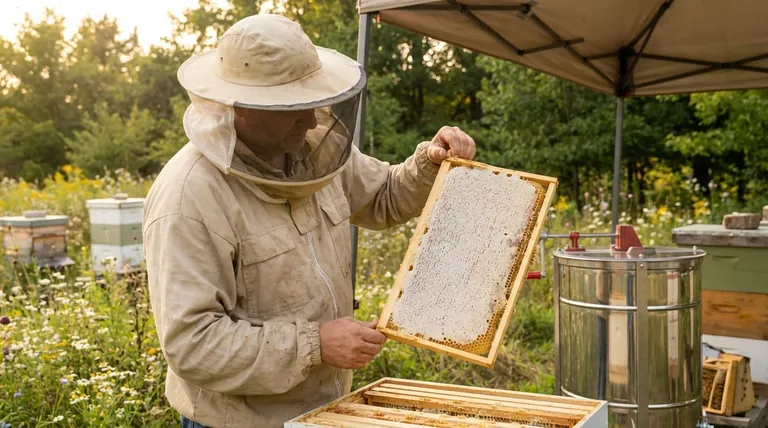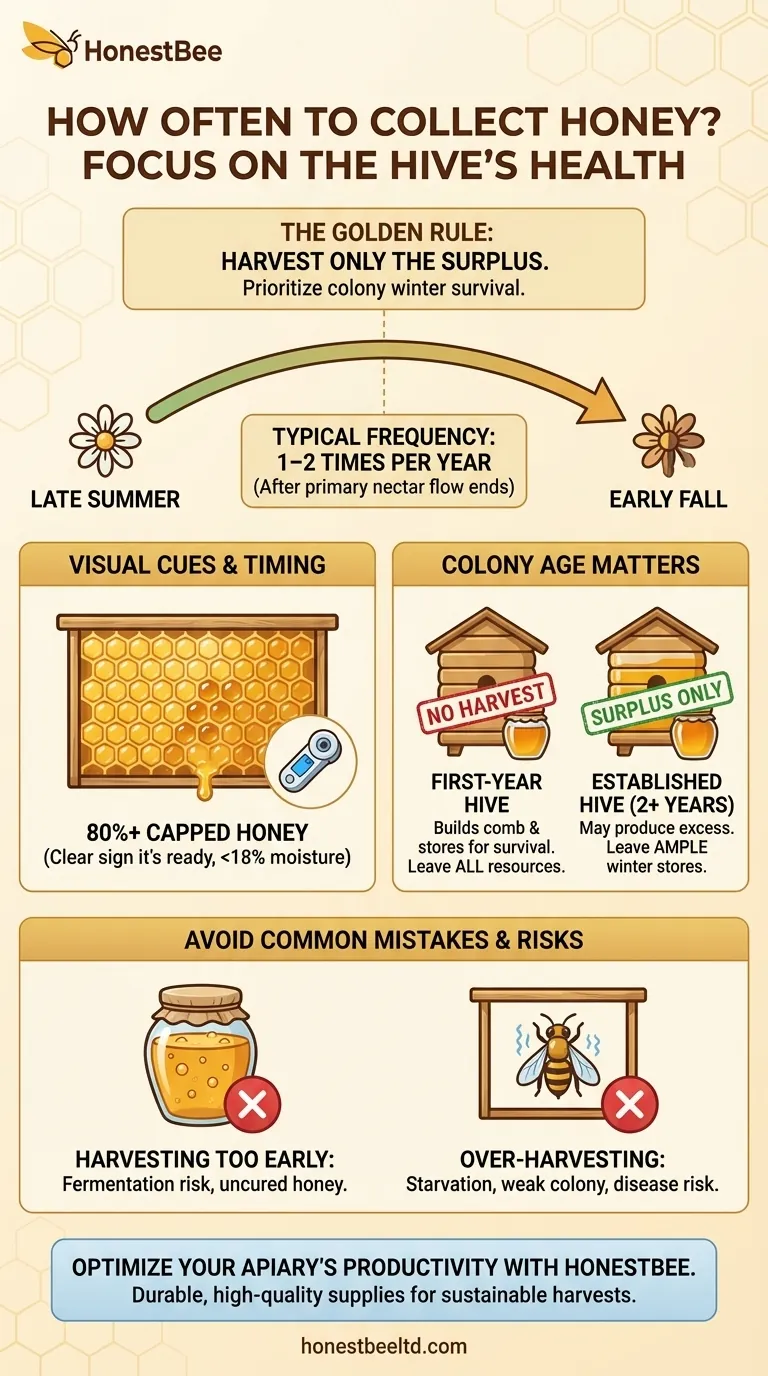In most established hives, beekeepers harvest honey once, or at most twice, per year. This typically occurs in the late summer or early fall after the primary nectar flow has ended. However, the frequency and timing are not based on a fixed calendar date but are entirely dependent on the health, age, and productivity of the specific bee colony.
The central principle of responsible beekeeping is that you only harvest the surplus honey. Your primary role is to ensure the colony has more than enough resources to survive the winter; the honey you collect is what remains after the bees' needs are fully met.

The Core Principle: Colony Health First
A honey harvest is a milestone, but it should never come at the expense of the bees. The honey they produce is their essential food source to survive the winter months when nectar is unavailable.
Why You Wait for an Established Hive
For new beekeepers, the first year is almost never a harvest year. A new colony expends all its energy building comb, raising young bees, and gathering just enough nectar and pollen to establish itself.
Taking honey from a first-year hive severely jeopardizes its ability to survive its first winter. All resources must be left for the bees to ensure a strong, healthy colony for the following season.
Defining "Surplus" Honey
An established, healthy hive in its second year or beyond can often produce more honey than it needs for winter. This surplus is what can be responsibly harvested. A beekeeper must learn to estimate the hive's winter needs based on their local climate and only take frames beyond that amount.
Reading the Signs: When is Honey Ready?
Determining the right time to harvest involves observing clear signals from the bees and the environment, not just looking at a calendar.
The Primary Visual Cue: Capped Honey
When bees have filled a honeycomb cell with honey and reduced its moisture content to the correct level (around 18%), they seal the cell with a fresh wax capping. This "capped honey" is the clearest sign that the honey is cured, ripe, and ready for storage.
As a rule, beekeepers wait until a frame is at least 80% capped before considering it for harvest.
The Timing Factor: The End of the Nectar Flow
Harvesting is typically done at the end of a major nectar flow—the period when the most abundant flowering plants in your area are in bloom. Harvesting after this peak ensures you are not taking honey that the bees are still actively processing.
The Technical Check: Moisture Content
While observing capped honey is the traditional method, some beekeepers use a tool called a refractometer to get a precise measurement of the honey's moisture content. Honey with a moisture level above 20% can ferment and spoil in storage. The bees' capping process is a natural way of ensuring the moisture is just right.
Understanding the Trade-offs and Risks
Harvesting based on a schedule rather than the hive's condition can lead to significant problems for both the beekeeper and the bees.
The Danger of Harvesting Too Early
If you harvest honey that is not fully capped, it likely has a high moisture content. This "uncured" honey is prone to fermentation, which will ruin your entire harvest. It also disrupts the colony's workflow before its work is complete.
The Critical Risk of Over-Harvesting
The most serious mistake is taking too much honey. This forces the colony into a food deficit for the winter. While you can provide emergency sugar syrup, it lacks the complex nutrients and enzymes found in honey. A colony that is underfed is weaker and more susceptible to disease and winter collapse.
The "Two Harvests a Year" Exception
Harvesting twice a year is not a standard practice and should be seen as an exception. This is only possible for exceptionally strong, productive hives located in regions with multiple, distinct nectar flows (e.g., an early spring flow and a late summer flow). It is not a recommended goal for new beekeepers.
Making the Right Choice for Your Hive
Your decision to harvest should be a direct response to the specific conditions of your colony.
- If you have a first-year hive: Your goal is colony survival, not a harvest. Plan to leave all honey stores for the bees to ensure they make it through the winter.
- If you have an established, strong hive: Wait until late summer, confirm that the honey frames are at least 80% capped, and be conservative, ensuring you leave ample stores for the bees' winter needs.
- If you are in a region with long, productive seasons: A second, smaller harvest may be possible, but only if the hive is booming and has clearly produced a new surplus after the first harvest.
By learning to read your hive and prioritizing its health, you ensure a sustainable and rewarding relationship with your bees.
Summary Table:
| Harvest Factor | Key Consideration |
|---|---|
| Typical Frequency | 1-2 times per year (late summer/fall) |
| Primary Visual Cue | Honey frames are at least 80% capped |
| First-Year Hives | No harvest; leave all honey for the bees |
| Core Principle | Only harvest the surplus after winter needs are met |
Optimize your apiary's productivity and ensure bee health with the right equipment. HONESTBEE supplies durable, high-quality beekeeping supplies and equipment—from honey extractors to protective gear—to commercial apiaries and beekeeping equipment distributors. Let our wholesale-focused operations support your sustainable harvests. Contact our experts today to discuss your apiary's needs.
Visual Guide

Related Products
- HONESTBEE 3-Frame Manual Acrylic Honey Extractor
- Electric 8 Frame Honey Spinner Extractor Equipment for Beekeeping
- electric honey extractor honey centrifuge 3 frame honey extractor stainless steel honey frame extractor
- HONESTBEE 72 Frame Industrial Electric Honey Extractor for Beekeeping
- Commercial Electric 12 Frame Honey Extractor Spinner Motorized Honey Extractor
People Also Ask
- What size honey extractor do I need? Match Frame Capacity to Your Hives for Maximum Efficiency
- How do you manually extract honey? Choose the Best Method for Your Hive
- How to extract honey by hand? A Guide to Crush & Strain vs. Manual Extractors
- What equipment is used for honey harvest? Essential Tools for Every Beekeeper
- How do you collect honey at home? A Beginner's Guide to Harvesting from Your Hive



















